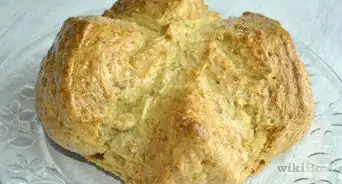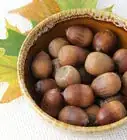wikiHow is a “wiki,” similar to Wikipedia, which means that many of our articles are co-written by multiple authors. To create this article, 23 people, some anonymous, worked to edit and improve it over time.
wikiHow marks an article as reader-approved once it receives enough positive feedback. In this case, 95% of readers who voted found the article helpful, earning it our reader-approved status.
This article has been viewed 209,818 times.
Learn more...
Oak trees tend to produce acorns in waves. For a few years, there might not be many, and then one year, they're all over the pace. If you're inundated with acorns this autumn, make the most of your bounty by turning them into nutritious flour. Keep reading for instructions on how to make flour you can use to make pancakes and bread, or soup.
Steps
-
1
-
2Shell the acorns. When dry, many will open themselves. If you wait for them to dry out, make sure that they get plenty of air, you don't want them to rot. If you have a dehydrator, you may consider speeding the process. Keeping them in the oven may work too if it has a pilot light.[2]Advertisement
-
3
-
4Rinse out the tannins. Acorns contain tannic acid which is bitter, and not good for your kidneys (or iron absorption). The good news is that it is water soluble and easy to remove.[4]
- If you made acorn mush, drape a cotton dishcloth over a deep bowl, pour in your mush and rinse it with warm water. Wring out the mush by bringing the corners of the towel together and twisting. Taste the mush, if bitter, repeat.
- If you have ground acorns, flush them with water. The amount of time it'll take to rinse out the tannins depends on which kind of oak tree the acorns are coming from. See the Tips below.
- Cold water. Place ground acorns in a large bowl of water. After the acorn meal settles out, decant the water. Repeat 2-3 times a day. If the acorns are from the black oak group, this can take 6-12 days. This method is best for maintaining the integrity of the kernel so that the resulting flour sticks together better (for making bread and other things).
- Running water. If you have an appropriate container, you can put the acorn meal in a stream and this will quicken the process.
- Hot water. Bring the shelled, pounded kernels to a boil and change the water every 45 minutes or so for about 6 or 7 hours of boiling. This works best in a large pot on a wood stove. You will know when they are done, as they will taste very bland (no bitterness and no astringency). This method is faster and doesn't require the kernels to be ground into a coarse meal (small pieces are fine), but it alters the texture of the kernels and they don't stick together as well.
-
5Dry out the mush. Next spread the mush out on a cookie sheet and either leave it in the sun on a hot dry day, put it in your dehydrator, or put it in your oven after baking some cookies or something and let the residual heat do the job. Stir the mush occasionally to speed the process. If it clumps up and looks like ground beef, it is probably going well.[5]
Community Q&A
-
QuestionDoes acorn bread taste good?
 Community AnswerIt tastes different from what you're used to, so don't expect it to be delicious when you first try it. It may take some getting used to, but if you're willing to try it and to expect a different flavor, you may grow to enjoy it.
Community AnswerIt tastes different from what you're used to, so don't expect it to be delicious when you first try it. It may take some getting used to, but if you're willing to try it and to expect a different flavor, you may grow to enjoy it. -
QuestionIs acorn flour better for you than wholewheat flour?
 Community AnswerWheat flour is not indigenous to North America; however, wheat has been around for thousands of years is from the Middle East and Europe. Native Americans often have a hard time with wheat, especially commercially processed wheat. Thus, for such peoples or for those with allergies, they may do better with acorn flour as it is a natural food in North America.
Community AnswerWheat flour is not indigenous to North America; however, wheat has been around for thousands of years is from the Middle East and Europe. Native Americans often have a hard time with wheat, especially commercially processed wheat. Thus, for such peoples or for those with allergies, they may do better with acorn flour as it is a natural food in North America. -
QuestionIs acorn flour gluten free? What is the nutrition information?
 Community AnswerAcorns are naturally gluten-free and loaded with fiber. For a serving size of one ounce, there are 142 calories, 15.5 grams carbs, and 2.1 grams protein.
Community AnswerAcorns are naturally gluten-free and loaded with fiber. For a serving size of one ounce, there are 142 calories, 15.5 grams carbs, and 2.1 grams protein.
Warnings
- Even acorns that taste relatively nice straight out of the shell (such as most members of the white oak group) still contain tannins and eating large quantities could cause troubles (e.g., stomach upset, loss of nutrients due to tannins binding with proteins).⧼thumbs_response⧽
References
- ↑ http://phytosphere.com/oakplanting/acorns.htm
- ↑ https://www.almanac.com/content/how-prepare-and-cook-acorns
- ↑ https://www.motherearthnews.com/real-food/how-to-make-acorn-flour-ze0z1509zcwil
- ↑ https://www.wildflower.org/expert/show.php?id=2947
- ↑ https://www.askaprepper.com/make-acorn-flour/
- https://ramshacklesolid.com/2008/09/making-acorn-flour/ - Original source, shared with permission.




























































